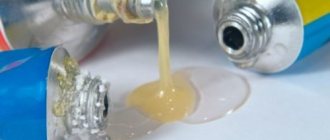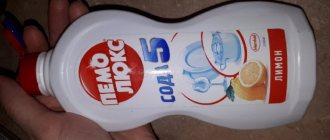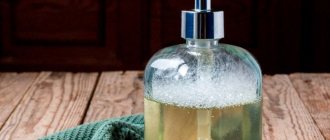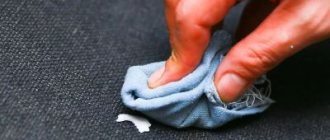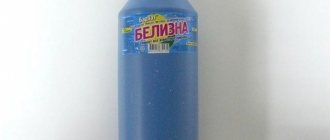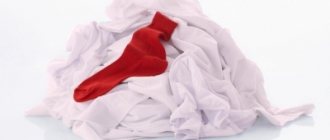02.02.202103.02.2021 Maria Ivanova
Not all stains can be removed once or twice; some cling to the fabric with all their might. And here the question arises: how to remove stubborn stains from dried blood, sweat, grease, wine or ink. After all, you really don’t want to throw away your favorite white dress or comfortable jeans.
There is really no need to resort to such radical methods. In most cases, clothing can still be saved. The main thing is to choose the most optimal method that matches the type of fabric and the nature of the stain. Why is this so important? Because it’s one thing to get rid of blood from a silk shirt, and quite another to remove grease from jeans.
Two most important rules
Before you wash stubborn stains, you need to pay attention to several important nuances. Firstly, no product is universal, that is, it is impossible, for example, to remove stains on silk and burlap using the same chemical. Secondly, it is necessary to establish the nature of the pollution in order to choose the optimal method to combat it.
What does this look like in practice?
Features of the material
It is imperative to understand what material you are dealing with and understand the composition of the fibers. All this information should be indicated on the label; there are also tips on washing (hand/machine; maximum permissible temperature) and care (is ironing allowed, is it permissible to use bleaches).
The most difficult thing to deal with is traces of old dirt on such delicate and “complex” materials as silk, velvet, gauze, chiffon, jacquard, nylon, viscose, etc. They absolutely do not tolerate chlorine bleaches, hot water and intensive washing. They also ambiguously apply to some folk remedies for removing stains.
How do you know that the product you choose (homemade or store-bought) will not harm the fabric? Before soaking the entire item in it, you should test it on an inconspicuous area (inner seam) and wait for the fabric to react. If the material does not deform and the color does not change, then it can be used.
In addition, it is also important that colored or white clothes need to be cleaned. For example, hydrogen peroxide is great for white clothes, but this chemical compound can ruin a bright dress. And on the contrary, some products work well in the case of colored clothes, but snow-white linen turns yellow or darkens.
Origin of pollution
Another point to consider when dealing with stains is the nature of the stain. The problem will be solved if the stain remover can enter into a chemical reaction with dirty marks. For example, fuel oil is removed from clothing using purified gasoline, and blood is removed using ammonia.
But let's find out what types of pollution are considered difficult to remove. This group includes traces from:
- blood;
- green grass;
- sweat discharge (especially if the item is not washed immediately);
- paints;
- fuel oil (bitumen, machine oil);
- some food products;
- ink;
- brilliant green, methylene blue;
- rust.
Old and complex food stains are conventionally divided into several subgroups. And each of them will have to be fought using special means.
Photo: https://pixabay.com/photos/red-wine-spill-spot-glass-red-505296/
What products leave stubborn stains on clothes? This:
- fat and oils;
- coffee;
- red wine;
- some fruits and vegetables (blueberries, currants, beets, etc.);
- jam and jam from some fruits;
- ketchup;
- tomato paste;
- juices from dark berries and fruits.
In addition, the “age” of the contamination is also important. The faster you start fighting stains, the easier it will be to get rid of them. And vice versa: old traces of almost any origin are much more difficult to remove. You will have to resort to aggressive means, and this increases the risk of ruining the item.
Special stain removers
It is easier to remove long-standing stains with special wide-spectrum stain removers, according to the manufacturers’ instructions.
Antipyatin
The stain remover contains components that have the ability to remove certain types of fresh and old stains:
- bile;
- glycerol;
- salt;
- caustic soda;
- nitrates based on saturated acids.
The product is available in the form of soap. Recommended for washing white and children's laundry.
Removal method:
- moisten the stained area with warm water;
- lather, rub, leave for 15 minutes;
- wash;
- rinse.
Water temperature for washing is up to 55 degrees. Rinse washed items in warm water.
Vanish
For stubborn stains on white and colored items, the use of active oxygen is effective. For cotton fabrics, stains are removed during the washing process by adding 60 grams of Vanish. Dirt from wool and silk fabrics disappears after soaking in bleach for 1 hour in warm water. Wash by hand.
Ace Oxy Magic
Oxygen-based bleach is intended for washing all types of fabrics (colored and white), with the exception of wool and silk, at a temperature of 30 degrees.
Udalix Oxi Ultra
Oxygen stain remover is used for washing clothes and linen with protein, oil, and mineral stains.
Astonish Oxi Plus
Old stains are removed after pre-soaking. A powerful oxidizing agent discolors stains:
- from greenery;
- blood;
- mold;
- red wine;
- milk;
- eggs;
- sauces;
- juices;
- buttered;
- resinous substances.
The product is used for machine and hand washing.
Bos
To remove stubborn stains, the manufacturer offers Bos plus Anti Stain spray. The main component is oxygen, which is able to remove food contamination from chocolate, wine, mayonnaise, milk, eggs. Suitable for all types of fabrics, including wool and synthetics. Not effective against stubborn stains of blood, juice, or wine.
How to remove stubborn stains - the most effective ways
There are two ways to deal with difficult marks - purchase a special stain remover, bleach, or use folk remedies. What to choose is up to you. We will tell you about the most effective methods and techniques, the reviews of which are very, very positive.
Fat (oil)
- Starch. The first option is especially relevant in the case of white things. The oil trace is covered with absorbent powder - starch, talc, chalk. This powder instantly absorbs fat. After this, the absorbent must be cleaned with a soft brush. If necessary, repeat the action. This method is most effective against fresh and small stains of oil and grease.
- Dishwashing gel. Another simple and effective way is to use regular dishwashing detergent. Dissolve 20 ml of washing gel in warm water and soak the contaminated item in this composition. After one or two hours, clothes can be washed in a washing machine at the maximum permissible temperature.
- Ethanol. How to remove stubborn grease stains? Alcohol will help deal with them, but at the same time it can discolor the fabric. Therefore, before dealing with oil marks on bright clothes, you need to test ethanol on an inconspicuous area. If the paints are preserved, you can proceed to full cleaning.
- Hot iron. Animal fats (butter, lard) can be dealt with by ironing. Before washing, iron the soiled fabric through the paper. To do this, place a clean sheet of paper under the stain and another one on top. The iron is heated to moderate levels and the fabric is ironed. The oil will transfer to the paper. Then the item is washed with powder.
Blood
Photo: https://www.pexels.com/ru-ru/photo/4623025/
The most important rule is that the fabric cannot be soaked in hot water, otherwise the protein compounds will coagulate (curl) and become firmly “embedded” in the fibers. At the same time, getting rid of a fresh stain is quite easy - just soak it in cold water and rinse thoroughly. You don't even need to use additional funds.
But getting rid of old traces is much more difficult. If we are talking about white clothes, use hydrogen peroxide. Blot a napkin or cotton pad with the mixture and apply it to the stain. Peroxide clarifies hemoglobin, so the blood trail becomes invisible. The procedure is repeated several times, and then the clothes are rinsed under cool water.
Another option involves using ammonia. First you need to prepare a solution: add 20 ml of ammonia to a glass of cold water. Soak cotton wool in the solution and apply it to the stain. When the blood is no longer noticeable, the clothes can be washed by hand or in a machine in the rinse mode.
Vegetables, berries and fruits
Tasty and healthy fruits contain natural pigments - a kind of dyes, which also change color over time. Particularly unpleasant and persistent stains include stains from tomatoes, beets, chokeberries, cherries, blueberries, tangerines, and raspberries. Contamination from fruit and vegetable juices is also difficult to remove.
Regular table vinegar (not essence) will help remove “fruit” stubborn stains on clothes. A cotton pad is soaked in acid and the mark is wiped until it disappears completely. You can also make an effective composition from baking soda: 10 grams of powder per 200 ml of warm water. The soda mixture is applied to the contaminated area, then the item is washed with soap or powder.
Another method is effective for white clothes and linen; it is not advisable to use it on colored fabrics. Mix hydrogen peroxide and ammonia in equal proportions. Pour the resulting solution onto the stain and wait a few minutes. Afterwards, the item is sent for washing with regular powder.
Berry and fruit traces can be removed using sour milk or yogurt. Clothes are left in it for several hours. After this, you should wash the item with laundry soap and rinse thoroughly. The effect can be fixed by washing in a washing machine.
Fuel oil
Photo: https://www.pexels.com/ru-ru/photo/279949/
Removing petroleum products from clothes is quite problematic. It is important to start cleaning as soon as possible. Pre-remove maximum contamination from the surface of the material. To do this, remove fuel oil or machine oil with a white cloth to prevent their further penetration into the fibers.
How to remove stubborn fuel oil stains at home? If the contamination is fresh, you can proceed as follows.
- Place white blotting paper on the contaminated area.
- A layer of crushed chalk and dry clay is applied to it.
- Cover the powder with another layer of blotting paper.
- Iron with a hot iron.
- Repeat the process several times to completely get rid of traces.
- Washing clothes in the machine.
This method is not suitable for delicate fabrics and heat-sensitive materials.
If the stain is old, then you can use chemical compounds. Thus, aviation gasoline, acetone, turpentine, solvents for degreasing metal (trichlorethylene), as well as specialized stain removers for resins and wax work well with traces of petroleum products. For example, Dr. Beckmann.
Rust
Unpleasant brown marks on light-colored clothing can be removed with citric acid. To do this, add 2 tablespoons of lemon to 200 ml of hot water. The resulting solution is applied to the stain with a cotton pad; you can also soak the contaminated area of clothing in the lemon mixture for 10 minutes.
Natural lemon juice also has similar whitening properties. To make homemade bleach, squeeze the juice from one citrus fruit and dilute it with two parts warm water. The contaminated fabric is kept in this solution for half an hour or 40 minutes.
The previous option is not suitable if the clothes are made of delicate or bright fabric. Less aggressive is a product made from glycerin, crushed chalk and water. All ingredients are mixed in equal proportions to obtain a homogeneous paste. It is applied to the rusty mark and left overnight. Then wash in soapy water and rinse.
Paints and varnish
Photo: https://pixabay.com/photos/child-colors-nepal-india-finger-3194977/
Before removing stubborn paint stains, you need to determine the type of contamination. The easiest way to get rid of water-soluble dyes, such as watercolor or gouache. To do this, you need to soak the clothes with a suitable washing powder, and then rinse the contaminated area thoroughly under running water.
It is not so easy to remove acrylic or latex, although when the stains are still fresh, they are cleaned off with a spatula and then held under water pressure. Another thing is that if the contamination is old, you will have to tinker. You can use acrylic paint thinner. Or make a vinegar-ammonia mixture. Both ingredients are mixed in equal proportions and salt is added. Wipe the area of contamination with the resulting composition.
The most resistant materials (and, therefore, stains) are alkyd enamel and varnish. To remove them, you need powerful solvents - turpentine and acetone. Apply the solvent to the stain with a cotton pad, and then, after the paint has softened, scrape off the composition with a knife. However, this method is not suitable for wool, silk, viscose and other delicate fabrics.
Sweat
Yellow spots in the armpit area cause discomfort. To get rid of fresh traces of sweat, use high-quality bleaches or folk remedies. The first option is lemon juice. Squeeze the juice from half a citrus onto the yellow mark and leave for a few minutes. Then rinse in cold water.
A baking soda paste is suitable for removing old stains. 80 grams of soda are diluted in 100 ml of water to obtain a runny paste. The composition is rubbed into contaminated areas of clothing and left for several hours. Then rub with a toothbrush, removing the white powder, and rinse in cool water.
Red wine
Remember how in the film “Office Romance” Novoseltsev tried to remove a red wine stain from Lyudmila Prokofievna’s dress with salt? In general, he was thinking in the right direction. Indeed, sodium chloride prevents the penetration of the drink into the fibers of the fabric. Therefore, you need to generously sprinkle salt on the wine stain, shake it off, and add the next portion. Then you just need to wash the item in cool water.
It is more difficult to get rid of an old stain when red wine has managed to penetrate deep into the fibers. Experienced housewives advise mixing glycerin with egg yolk and lubricating the resulting mixture onto the stain. Wait a few hours, and then wash your clothes in lukewarm water with any washing powder.
Zelenka
Zelenka is still popular in the countries of the former USSR. It helps to disinfect wounds, but if you use it carelessly, you can get a bright green stain. How to remove green stains from clothes? Fresh marks can be washed off with hot water. Another option is to smear the dirty area with laundry soap and then wash it in the machine.
Old brilliant green stains can be treated with starch. The contaminated area is moistened with warm water, sprinkled with starch, distributed over the surface, then washed off. The procedure is repeated several times until the green spot is completely removed.
If this doesn't help, use acetone. A cotton pad is moistened in a volatile liquid and wiped over the fabric until the stain disappears. It is important to understand that acetone is a rather aggressive chemical compound. Therefore, it can only be used on dense materials.
Basic Rules
The first and basic rule to remember is that almost all types of stains are easier to remove while they are fresh. In the first 30-120 minutes, it is enough to spill or wash the stain with water or a damp cloth.
However, there are exceptions. So, it is better not to try to clean fresh dirt and drops from a melted candle, so as not to smear them. In the first case, you need to let the clothes dry and brush off the dirt with a brush. In the second, try to apply low temperature to the soiled items; the wax will harden, become brittle and be easily removed.
The next important point: before removing a stain from clothing, you need to make sure that the stain remover is safe for the material. To do this, apply a drop of the product to the hem of the bottom or in another inconspicuous place. If the tissue does not change, then the product can be used.
What will “kill” different types of fabrics?
Before washing, it is important to study the composition of the material given on the product label. There are also rules of care that cannot be violated. For example, if a product can be washed at 30 degrees, then you should not try to remove the stain by pouring boiling water on it.
If there is a symbol on the label that says the product cannot be washed, then it is better to take it to the dry cleaner without trying to remove the stain at home.
Need to remember:
- It is prohibited to clean synthetic fabrics with organic solvents;
- artificial silk will be destroyed by acids, solvents, and hydrogen peroxide;
- dyed fabrics are likely to become discolored when treated with hydroperite solution or chlorine bleach;
- Eco-leather cannot be treated with organic solvents.
You need to handle silk, lace and wool items very carefully.
Procedure
It is not recommended to use concentrated products to remove stains; it is better to dilute them with water. A substance that is too aggressive will negatively affect the fabric. If the trace is not cleared on the first try, the processing can be repeated.
To remove a stain you need to:
- turn the thing inside out;
- straighten it by placing a white cotton cloth folded several times on the front side under the stained area;
- aggressive stain remover should not be poured onto the fabric; you should moisten the swab and carefully treat the stains;
- you need to move strictly from the edges to the center, otherwise the mark will only increase in diameter;
- and to prevent a dirty halo from appearing on your clothes from smeared stain remover, you should sprinkle starch, talc around the perimeter, or at least moisten it with water;
- If hard brushing is required, it is better to use an old toothbrush.
Work should be carried out in a well-ventilated area, preferably in bright sunlight.
How to remove an unknown stain
Unfortunately, it is not always possible to determine the nature of the contamination, especially if it is old. In this case, it is best to take the item to the dry cleaner, where specialists will be able to remove almost any stain. If this is not possible (or desired), try removing the unknown trace using laundry soap. This is a universal remedy.
If it doesn’t help, you can move on to more effective formulations - peroxide, ammonia, turpentine, acetone. True, these compounds are not suitable for all types of fabric - for example, acetone can disrupt the fiber structure of silk or wool. In addition, hydrogen peroxide has brightening properties.
In general, you always need to focus on the features of the thing. To do this, it is important to study the information on the label.
Machine or hand wash
After removing the stain using one of the above methods, the T-shirt should be washed. This can be done either manually or by machine. There is no fundamental difference between them, but in both cases it is necessary to follow a few simple rules:
- sort things by color: white linen is only white, dark linen is dark, and colored things are by color and shade;
- pre-soaking for heavily soiled items;
- Wash again if grease or sweat stains are not removed the first time.
Things to consider before removing stains
Origin of the stain.
The cleaner is selected for a specific type of stain. That's why professional stain removers have products for different stains: for example, Dr. Beckmann produces separate products for ballpoint pen and felt-tip pen stains, glue, blood and protein stains. If you choose the wrong cleaner, it will not dissolve the stain.
This is important to consider when choosing a washing method. For example, fat is easier to wash off with hot water, and blood is easier to wash off with cold water.
Type of fabric.
Need to consider:
- Composition of the material. The most difficult stains to remove are from delicate fabrics: satin, velvet, wool, silk, fine synthetics. They do not tolerate aggressive household chemicals and friction. Nylon or silk acetate may dissolve along with the stain after applying acetone or solvent. Natural fabrics are less picky about the composition of the cleaner due to their loose structure, but they absorb dirt more strongly, so they are difficult to wash the first time.
- Color. White clothes can be washed with almost any stain remover without worrying about discolouration. But to treat colored fabrics, you cannot use hydrogen peroxide, chlorine-containing products, solvents and citric acid.
General rules.
If you have a stain, read the recommendations before washing:
- Check the tag. On the label, manufacturers indicate recommendations for care - washing and drying.
- If you are not sure about the effect of the product, test it on a small piece of cloth. A sample attached to a tag will do.
- Immediately blot fresh stains with a dry cloth and cover with salt or starch so that the marks do not spread.
- If possible, wash your clothes as quickly as possible. But try not to rub the fabric too much so that there are no pellets left on it.
- It is better to take clothes made from delicate fabrics to the dry cleaner immediately. Experimenting with folk remedies and aggressive compounds can ruin the color or structure of the fabric.
Features of removing traces of fat from T-shirts of different colors
When choosing a method for treating a T-shirt from grease stains, it is recommended to take into account the color of the material. This will allow you to restore the item to the highest possible quality.
White
After quick response methods have been used to remove grease stains, it is possible to remove the remaining traces using a stain remover for white fabrics . A soiled T-shirt must be treated with a stain remover, according to the instructions for the specific product, and the item must be left to lie.
A cotton T-shirt without synthetic fibers in its composition can be exposed to high temperatures. To do this, boil the kettle, pour boiling water over the stain, turn the item inside out and repeat the treatment. The fat will break down from this effect.
For white T-shirts, which contain not only cotton, but also synthetic fibers, exposure to boiling water is not suitable. This item can be pre-soaked. After removing the stain, the item is washed at the maximum permissible temperature using detergent. In this case, white items must be washed separately from dark and colored items.
In addition to purchased products, white T-shirts can be treated with hydrogen peroxide, ammonia with soda and whitening toothpaste.
Black
For black and dark clothes with fresh greasy stains, you can use Coca-Cola as a stain remover . Its effectiveness is due to the inclusion of orthophosphoric acid.
The T-shirt is completely immersed in the undiluted drink and kept until the stain disappears. Mustard powder and commercial stain removers approved for use on dark fabrics can also be used.
Colored
Processing a colored T-shirt is a procedure that retains the risk of discolouration of the brightly colored material.
Home remedies should be used with caution. The safest method for removing old stains is a mixture of water, salt and ammonia .
Store-bought products should only be chosen that are designed for processing colored items or are universal.

